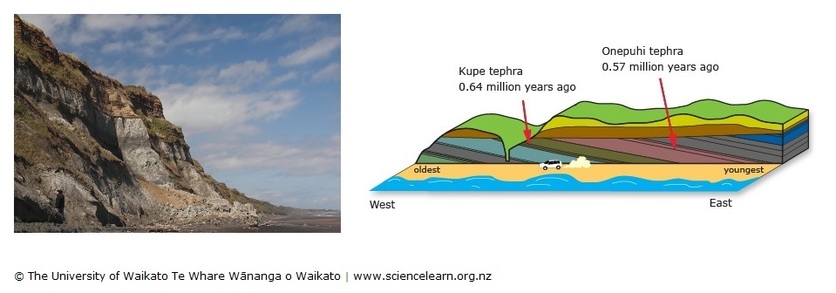Relative dating is used to arrange geological events, and the rocks they leave behind, in a sequence. The method of reading the order is called stratigraphy (layers of rock are called strata). Relative dating does not provide actual numerical dates for the rocks.
Next time you find a cliff or road cutting with lots of rock strata, try working out the age order using some simple principles:
- Sedimentary rocks are normally laid down in order, one on top of another. In a sequence, the oldest is at the bottom, the youngest is at the top. This is the principle of ‘superposition’.
- Most sedimentary rocks are laid down in flat (horizontal) layers, although these can later tilt and fold. This is the principle of ‘horizontality’.
- Layers of sedimentary rock extend sideways in the same order. A later event, such as a river cutting, may form a gap, but you can still connect the strata. This is the principle of ‘lateral continuity’.
Fossils and relative dating
Fossils are important for working out the relative ages of sedimentary rocks. Throughout the history of life, different organisms have appeared, flourished and become extinct. Many of these organisms have left their remains as fossils in sedimentary rocks. Geologists have studied the order in which fossils appeared and disappeared through time and rocks. This study is called biostratigraphy.
Fossils can help to match rocks of the same age, even when you find those rocks a long way apart. This matching process is called correlation, which has been an important process in constructing geological timescales.
Some fossils, called index fossils, are particularly useful in correlating rocks. For a fossil to be a good index fossil, it needs to have lived during one specific time period, be easy to identify and have been abundant and found in many places. For example, ammonites lived in the Mesozoic era. If you find ammonites in a rock in the South Island and also in a rock in the North Island, you can say that both rocks are Mesozoic. Different species of ammonites lived at different times within the Mesozoic, so identifying a fossil species can help narrow down when a rock was formed.
Correlation can involve matching an undated rock with a dated one at another location. Suppose you find a fossil at one place that cannot be dated using absolute methods. That fossil species may have been dated somewhere else, so you can match them and say that your fossil has a similar age. Some of the most useful fossils for dating purposes are very small ones. For example, microscopic dinoflagellates have been studied and dated in great detail around the world. Correlation with them has helped geologists, such as Professor James Crampton, date many New Zealand rocks, including those containing dinosaurs.
Activity idea
Bring relative dating principles to life with the activity Rock layers and relative dating. Students begin by observing a photograph and a diagram of rock layers near Whanganui, watch an animation about how the layers were formed, then use an interactive labelling diagram to work out the order in which the rocks were created. The activity offers literacy opportunities as well as practice using the science capability 'Interpret representations'.





